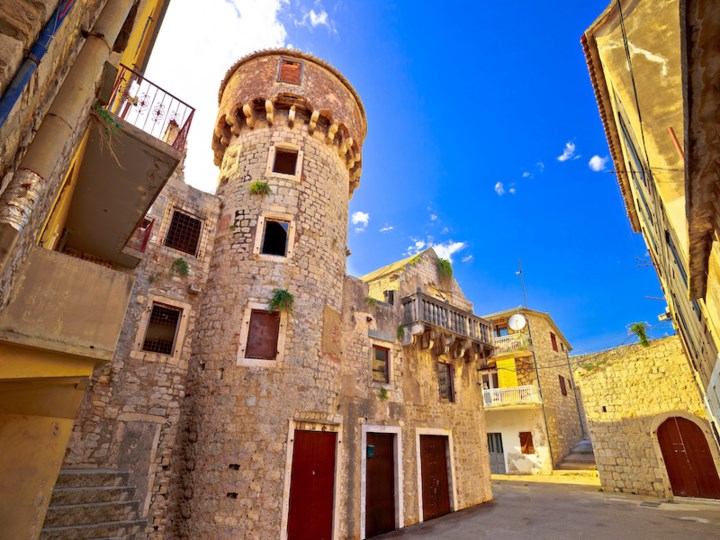Crystal clear turquoise blue sea, the warm shining sun and rich vegetation in all shades of green - that is
Central Dalmatia.
But sometimes it's worth taking a closer look. Between
Trogir and Solin, protected by the
island of Ciovo and the Split peninsula, there are
7 stone pearls - the "Kasteli".
The natural inland border is formed by the Mosor massif, the Kozjak and Opora mountains. A 20 km long stretch of coast lets the country run into the sea.
This
region was settled early on, namely by the Neanderthals, which remains in the Mujina Pecina cave prove. The
Greeks and the Romans developed civilisation and economy here. Shortly after Venice conquered Dalmatia in 1420, the
Turks attacked and around 20 forts were built to protect the population and the fertile land. Around them are
7 interconnected settlements, which we now know as the Kasteli - unmistakable features are the ancient villas, protective walls, small old churches and castles. Each of these places has its own characteristics and manifestos.
Kastel Stafilic, near Trogir, is known for the
never-completed Bastion Nehaj, which, with its strange-looking appearance, protrudes from the sea at high tide and attracts artists, historians and tourists alike. In addition, this place is adorned with a natural monument: "Mastrinka", a 1500-year-old olive tree that has survived the turbulent history of the city to this day.

In
Kastel Novi you should visit the
Biblical Garden with its small
church “St. Mother of Stomorje ”. The fertile soil and caring nature lovers ensure that olives, figs, grapevines, laurel, acacia, aromatic plants and herbs thrive. Wine connoisseurs will recognise and enjoy the
world-famous Zinfandel in the Kastelan Crljenak.
Kastel Stari shines through the
fortress Cipico, which the squire, writer, humanist and military leader
Koriolan Cipiko once
built as a palace together with the main square on a rock in the sea - only connected to the mainland by a flat footbridge. The city is popular with families, hikers and mountaineers as it is an
ideal starting point for mountain hikes at the foot of the Kozjak.
 Kastel Luksic
Kastel Luksic is the
cultural center of the city. Exhibitions, concerts, theatre performances and festivals take place here, including the
festival of love “Dani Miljenka i Dobrile”. The legend tells the story of two lovers - Miljenko and Dobrila - a love that ended tragically despite their wedding.
The restored
Vitturi Castle with the Museum of the City of Kastela is worth seeing for sure.
Vitturi Park has been designated an "architectural monument" - and rightly so, as you will see. A visit to the botanical garden at the Ostrog elementary school, which was created by students and teachers and has been awarded with several prizes, is also a must if you are in Kastel Luksic.

In
Kastel Kambelovac - named after the
noble brothers Jerolim and Nikola Cambi, who had
several fortresses built here - the
first ballet school in Dalmatia was founded after the Second World War. Today it is a music school. A special kind of music additionally promoted the popularity of the city, as
Klapa Cambi, the most successful and best-known a capella group in Dalmatia, if not even Croatia, comes from Kastel Kambelovac.
Kastel Gomilica was
originally called Kastel Opatica because the settlement was
built by the sisters ("opatice") of the Benedictine order of Split. The islet Gomile on which the fortress was built, gives it its current name. Here the scenes for the fourth season of
Game of Thrones were taken. If you are a fan of the series, a short visit is essential!
 Kastel Sucurac
Kastel Sucurac is the closest to Split. Because of its reputation as an industrial suburb, it is
often underestimated culturally, but will be happy to convince its visitors otherwise. It has the
best preserved old town in Kastela. The episcopal palace with its Gothic windows houses a small museum, and the bell tower of the old parish church is the only remnant of the
devastating bombing raid by the Allies in 1943. From Kastel Sucurac you can take
hiking trails to the Vrata yoke at the back of the Kozjak mountain.
If you have booked one of our villas in Dalmatia, the 7 Kasteli with all their differences and similarities would be an excellent way to get to know the typical features of the region and to avoid the tourist crowds in Split and Trogir - sightseeing in a quiet way. Enjoy it!
Daniela Vuleta
12.02.2021

 MY ISTRIA GUIDE
MY ISTRIA GUIDE




